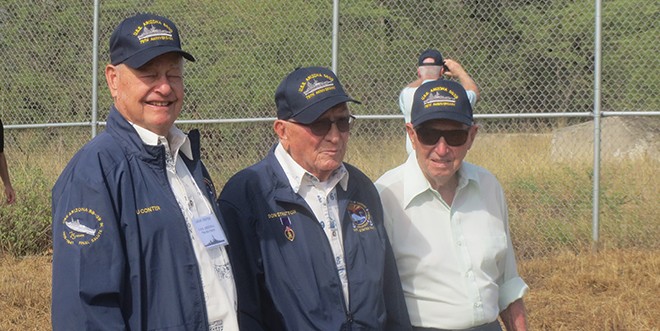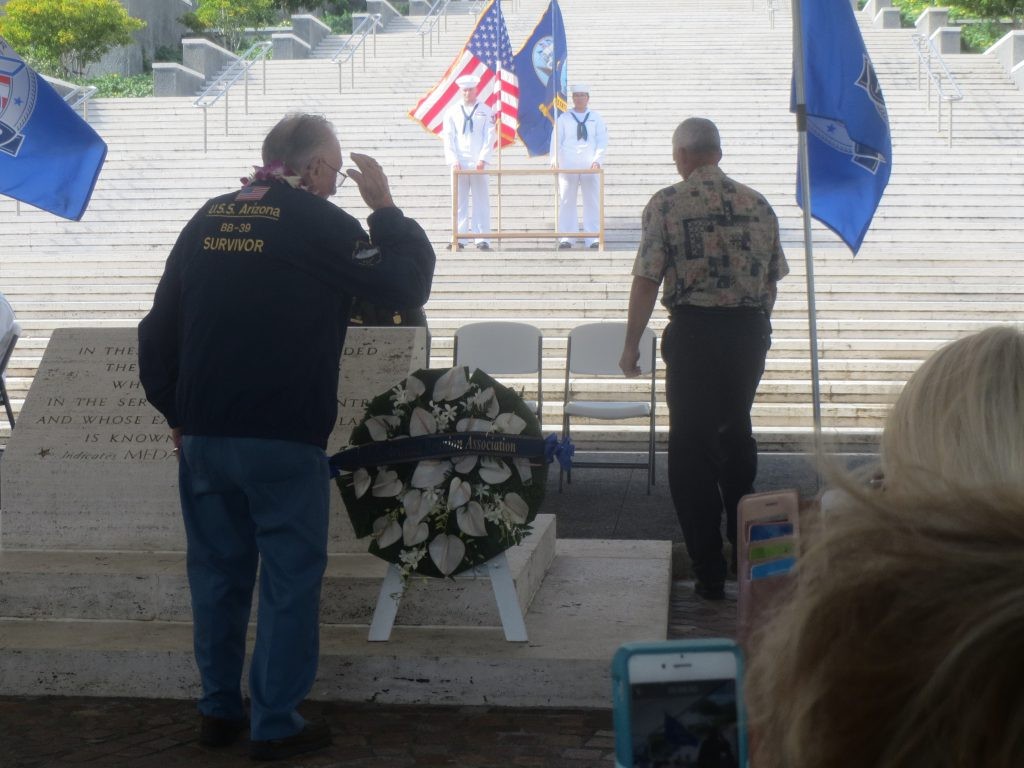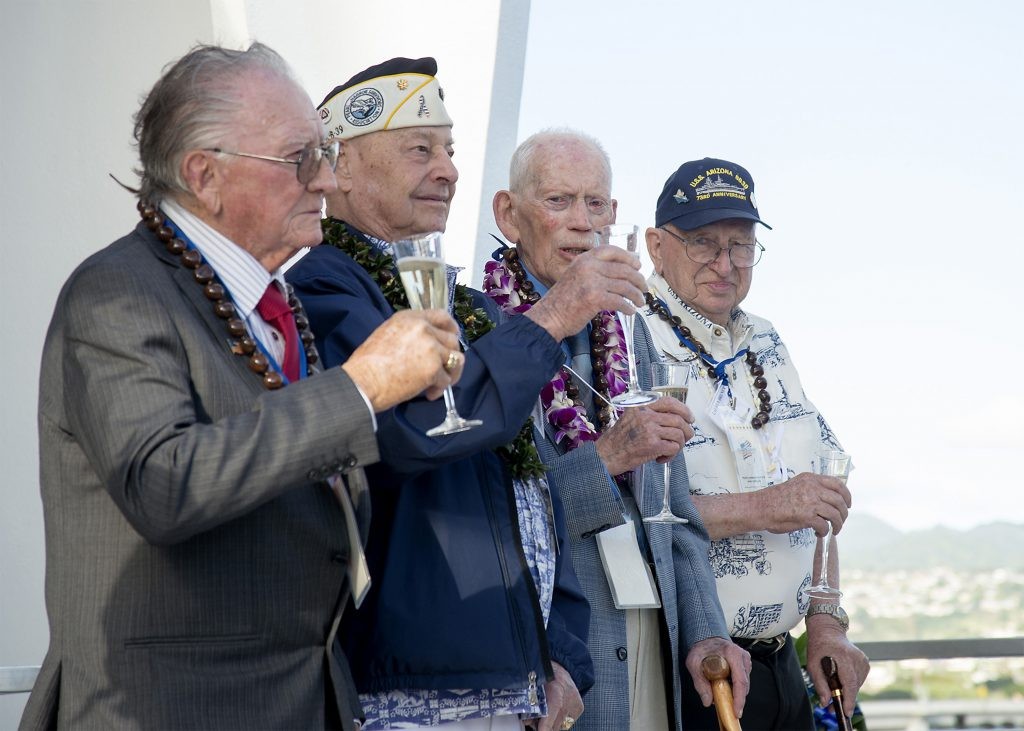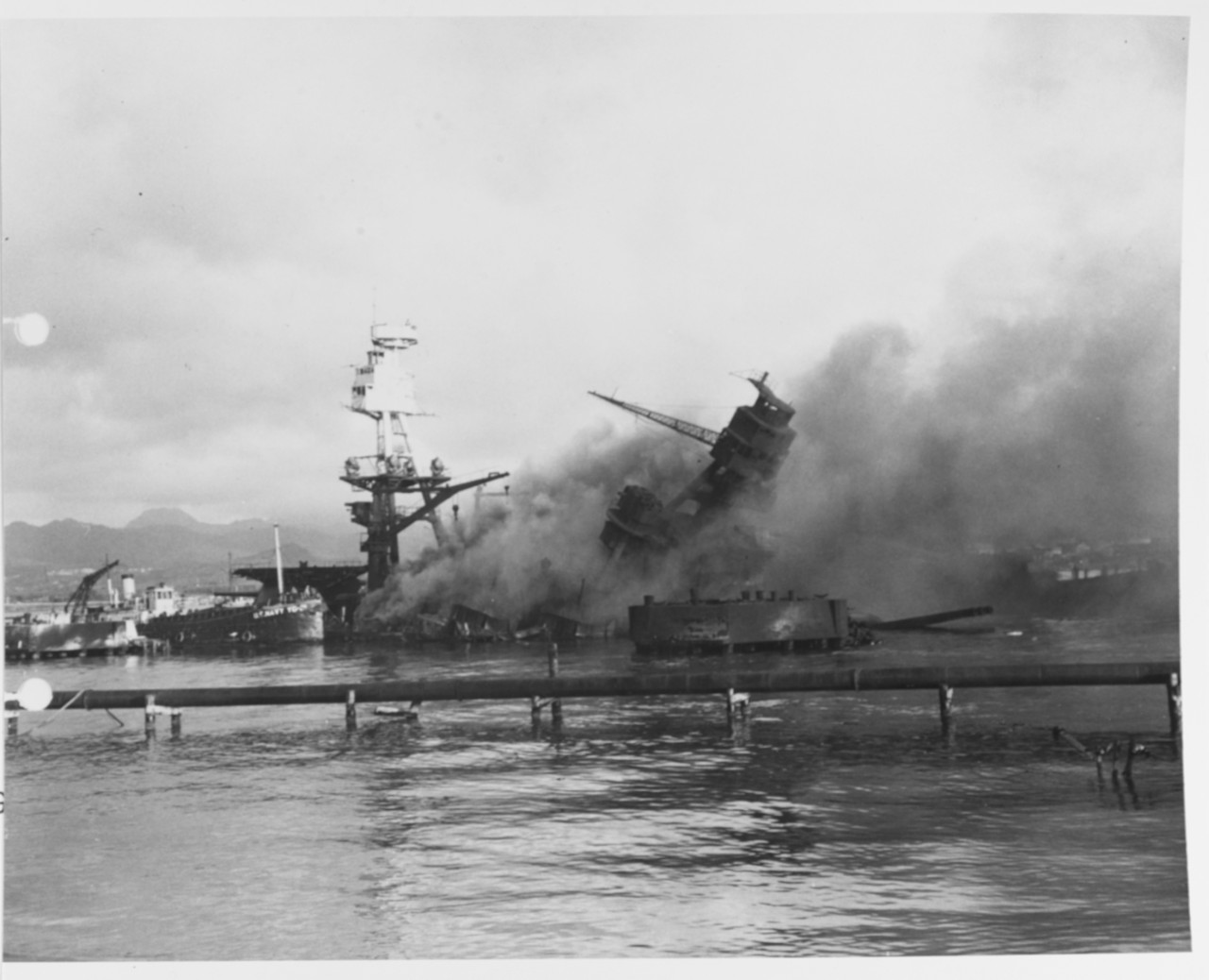Fair Winds, Donald Stratton, USS Arizona Hero

In December 2016, three of the then-remaining five survivors of the USS Arizona (BB-39) attended the 75th anniversary of the Japanese attack on Pearl Harbor. Don Stratton is pictured center. Arizona, as well as much of the Pacific Fleet, was in port when Pearl Harbor suffered a surprise attack by the Japanese on Dec. 7, 1941, propelling the U.S. into World War II. During this raid, Arizona was hit by one torpedo and eight bombs, one of which passed through a magazine and lit cordite, causing an expansion of gases followed by a massive explosion. The ship quickly sank to the bottom of the harbor along with 1,177 of the 1,512 personnel on board, representing about half the total number of Americans killed that day.
(Originally published on the NHHC Sextant blog on February 21, 2020.)
By Samuel J. Cox Rear Adm., USN (retired) Director of Naval History, Curator for the Navy Director, Naval History and Heritage Command
A note from the editor: Donald Stratton, who served in the Navy aboard USS Arizona (BB-39) during the attacks at Pearl Harbor, and later in the Western Pacific, passed away February 15, 2020, at the age of 97.
It is with deep regret that I write of the passing of another Navy hero, Donald Stratton, on February 15, 2020, at the age of 97.
Severely burned aboard the battleship USS Arizona (BB-39) during the Japanese surprise attack on Pearl Harbor, Stratton was medically discharged from the Navy. But after a year at home in Nebraska, he talked his way back into the Navy, serving aboard the destroyer USS Stack (DD-406) in combat in the Western Pacific in 1944-45.
On December 7, 1941, Stratton was a Seaman First Class aboard Arizona when her forward magazine exploded as a result of a Japanese bomb. The massive explosion killed almost everyone in the forward two-thirds of the ship; only 93 men who were aboard the ship that morning survived (242 others who were ashore on liberty or working parties also survived). A total of 1,177 died, including Rear Admiral Isaac Kidd and Captain Franklin Van Valkenburgh (both would receive a posthumous Medal of Honor).
For the few minutes of her combat life, Arizona had put up a terrific barrage by her 5-inch anti-aircraft guns. However, the rate-of-fire outstripped the ammunition in the ready-use lockers, nor could the guns train in elevation sufficient to reach the high altitude bombers (Kate torpedo bombers being used in a horizontal bombing role) overhead. Thus, Arizona was defenseless against the plane that dropped the modified armored-piercing shell that destroyed her, not because of the training or courage of her Sailors, but because her weapons were simply inadequate. The anti-aircraft guns were being directed from two lightly armored gun directors (port and starboard) on the Sky Control deck atop the forward superstructure. The guns were installed in a recent overhaul in a belated and insufficient attempt to improve the ship’s capability against rapidly evolving aircraft technology. A handful of men at their battle stations in these gun directors miraculously survived the blast, all of them badly burned. One of them was Stratton. Another was Lauren Bruner, who passed away last September. All of them were trapped by the roaring inferno all around, as the foremast and forward superstructure melted and sagged into the void left by the explosion. Some made a futile attempt to jump and others were killed by continuing Japanese strafing and shrapnel from more bombs and secondary explosions. Those who survived were witness to ghastly sights that would haunt them for the rest of their lives.
Ultimately, only six men remained alive on the Sky Control Deck, including Stratton and Bruner. All six made it down a line that had been thrown by Boatwain’s Mate Second Class Joseph George, a crewman on board the repair ship Vestal (AR-4) which was moored outboard Arizona. Many of Vestal’s crew, including the commanding officer, CDR Cassin Young, were blown overboard by the force of the blast on Arizona, or forced to jump overboard due to the intense heat from the fires on Arizona and burning oil drifting down on Vestal. CDR Young and others climbed back on board Vestal, which was sinking due to bomb hits, getting her underway as quickly as possible with the intent to beach her (CDR Young would be awarded a Medal of Honor). With no time to spare before the line had to be cut, Stratton was the second man to come hand-over-hand, despite his burned hands, down the already smoldering line. Bruner was the second-to-last. Two of the men who came down the line succumbed to their burn injuries, one quickly and the other suffering for a month.
Stratton was badly burned over two thirds of his body. He refused doctors’ recommendations to amputate his limbs and endured months of intense pain and morphine hallucinations. His wounds were so bad that he was medically discharged from the Navy. But, after a year at home, he couldn’t stand to be on the sidelines of the war. He convinced the Navy to re-enlist him, and he went through boot camp again. In the summer of 1944, he was assigned to the destroyer USS Stack (DD-406.) Stack laid a minefield off Wewak, New Guinea, shelled Japanese positions near Wewak and was part of the assault force that captured Morotai as an advance base for the invasion of the Philippines. Stack then participated in the landings at Leyte and then Lingayen Gulf, providing gunfire support to forces ashore and anti-aircraft defense against kamikaze attacks. After several escort operations, Stack participated in the initial landings on Okinawa and defending against the massed kamikaze raids that occurred in the spring and summer of 1945. Stratton was honorably discharged at the end of the war.
After the war, Stratton lived a relatively normal life, working as an able-bodied seaman and deep sea diver on oils rigs and craft on the West Coast. In about 2001 he commenced a quest, along with Bruner, to have the Navy award a medal for valor to the Sailor who saved their lives, Joseph George, who had passed away in 1996. The quest became quixotic because of the requirement for the award to be submitted by an officer with first-hand knowledge and two witnesses. Although there were two witnesses, Stratton and Bruner, Captain Cassin Young had been killed in action at Guadalcanal in command of the heavy cruiser USS San Francisco (CA-38) along with RADM Dan Callaghan. Callaghan was awarded a posthumous Medal of Honor and Young a Navy Cross. No other officers from Vestal or Arizona who might have witnessed the event were alive by then either. Nevertheless, Stratton and Bruner doggedly persisted.
I had the honor to meet both Stratton and Bruner during the 75th Anniversary of the Attack on Pearl Harbor in 2016, where I learned of their efforts on behalf of Joseph George. The logjam finally broke when then-LTJG Matt Previts found a re-enlistment card for Joseph George in the Archives that had a statement on the back attesting to George’s actions in saving crewmen from Arizona, signed by the commanding officer of Vestal, Cassin Young. Using that, I argued that the signature on the card sufficed to meet the “officer” requirement. Navy leadership agreed and on December 7, 2017, RADM Matthew Carter presented the family of Joseph George with a posthumous Bronze Star with Combat “V” at a ceremony at Pearl Harbor.

USS Arizona (BB-39) survivor Don Stratton pays tribute to the Sailors lost on the ship during a wreath laying ceremony at the National Cemetery of the Pacific at Punchbowl in Honolulu. The ceremony provided the opportunity for those in attendance to honor the fallen men of the Pennsylvania-class battleship USS Arizona.
Just prior to the 75th Anniversary of the Pearl Harbor attack, Stratton finally told his story with author Ken Gire, All the Gallant Men: The First Memoir by a USS Arizona Survivor. It is an emotionally powerful story of the shock of going from peace to combat to disaster in the space of a few minutes.
Donald Stratton epitomized the men of the “Greatest Generation,” a child of the Great Depression who found a home in the pre-war Navy, only to have it destroyed in a matter of minutes by a World War. After what he went through on Arizona and months of agonizing recovery, no one in the world would have faulted him for taking his medical discharge and remaining safe at home. But that was not Don Stratton. He knew shipmates were still fighting for our nation’s freedom, and he wanted to be with them. The re-enlistment officers questioned his sanity, but he persisted and persevered and was serving aboard a ship in Japanese waters when final victory was achieved. And like most veterans of that war, he never considered himself a hero. But he certainly was.
With Don’s passing, Lou Conter and Ken Potts are now the only two remaining survivors of the Arizona.
May you rest in peace, Don.

141207-N-IU636-610 PEARL HARBOR (Dec. 7, 2014) Four of the nine remaining USS Arizona survivors, Donald Stratton, left, Louis Conter, John Anderson, and Lauren Bruner, toast in honor of fallen shipmates and service members of the Dec. 7, 1941, Japanese attack on Pearl Harbor aboard the USS Arizona Memorial at Joint Base Pearl Harbor-Hickam. The four Pearl Harbor survivors announced this year’s USS Arizona Reunion Association ceremony to be the final of its kind. The final toast symbolizes the brotherhood and sacrifice of the day of the attack on Pearl Harbor 73 years ago. More than 2,500 guests, including Pearl Harbor survivors and other veterans, attended the National Park Service and U.S. Navy-hosted joint memorial ceremony at the World War II Valor in the Pacific National Monument. (U.S. Navy Photo by Mass Communication Specialist 2nd Class Johans Chavarro/Released)



